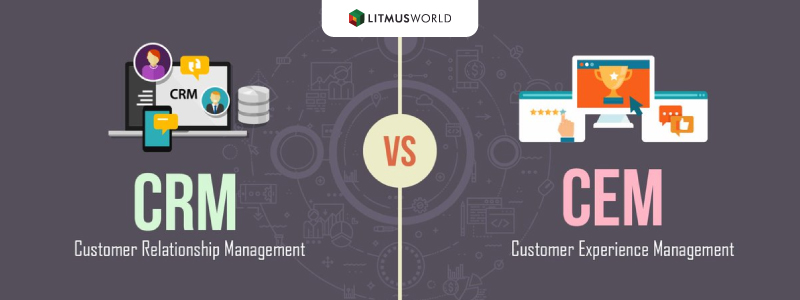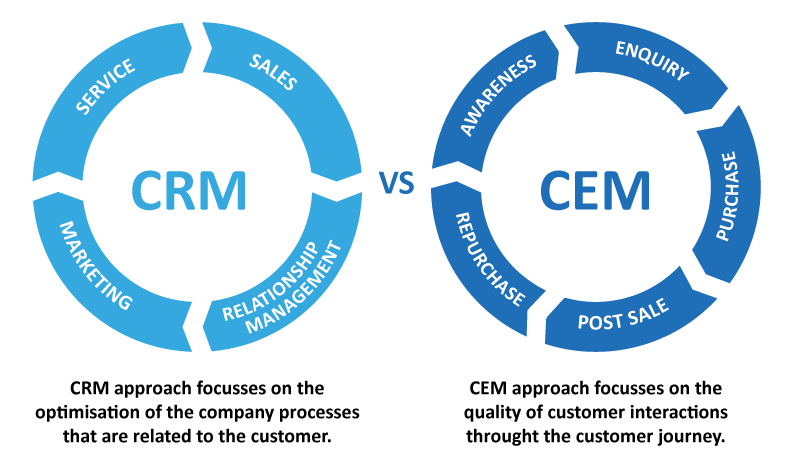Why using only CRM platforms can kill CX
CRM vs CEM – Why using only CRM platforms can kill your CX programme

Customer Relationship Management (CRM) and Customer Experience Management (CEM) may sound like they both serve the same purpose – both deal with keeping customers happy – but there is a gap between them, in terms of the data they collect, and the function that data performs.
Let’s discuss these differences, and why just a CRM platform may not be enough to improve your customer experience, especially for large organisations with complex business processes.
What is Customer Relationship Management?

CRM is a platform that helps you optimise those business processes that are related to the customer. The focus of CRM is sales, so it works towards improving marketing, after-sale services, and relationship management, to ensure customer issues are resolved in a timely manner.
In that sense, CRM has a narrow approach.
What is Customer Experience Management?

CEM is an extension of CRM, but it shifts the paradigm. Instead of sales being the focus, the customer is the focus. Instead of selling them a product directly, what you sell them is an experience, and what you measure is their interaction with this experience.
It’s a more holistic approach, and it doesn’t come into play when the customer is in the decision-making phase. It comes into play a whole lot before – right from when your customer visits your store, lands on your app, or visits your website. Or even before: when your brand, for example, is recommended to them by a friend or family member.

Where CRM works
CRM is a great tool if you’re looking to engage with existing customers, and ensuring that your relationship with them remains happy and positive.
The data gathered by CRM tools also assist in tracking customer behavior, how often they spend, how much they spend, and how they interact with your website, frontline employees, or app.
It’s more passive gathering data and gives you insights after the fact.
However, in a markedly digital world, what you need are more dynamic solutions and contextual conversations. This is where a CRM system fails.
Where CRM fails
While CRM tracks data from a business viewpoint, CEM tracks data from a customer viewpoint.
For example, from a business and cost perspective, you may decide that three touchpoints are enough to bring your customer from website to product. But from a customer perspective, three touchpoints may not be enough. You may need to define more.
CRM works on optimising current business processes. CEM will tell you how you can improve your processes and the customer experience.
Since the approach of CRM (business) is different from CEM (customer), relying on just a CRM system to check the success of your CX programme will not lead you to the results you’re expecting to achieve.
How CEM can help you thrive

The way a customer behaves, whether in the B2C or the B2B space, has evolved – and more so in the pandemic. With everything going digital, it is necessary to reinvent the B2B Customer Experience.
For example, a customer may be disgruntled with your website during the sales season due to technical glitches. If you don’t capture that feedback, you won’t be able to ensure that it isn’t repeated with the next customer.
At every juncture of your customer’s journey, feedback is important. This means a large amount of data is being collected. The more complex your processes, the more bandwidth you need to sift through the data and arrive at actionable points.
Why upgrade to the Customer Experience Management model?
While CRM focuses on the more transactional nature of the customer journey, CEM focuses on the experience they had while interacting with your brand.
CRM wants to optimise and work on customer satisfaction. CEM though wants to increase customer satisfaction, loyalty, and advocacy.
In terms of data, CRM is a platform in itself and provides little scalability or customisation. CEM deals with real-time conversations with an engaging UI that ensures better response rates. There are other journey metrics like reminders, text changes, and a secure, scalable, and customisable platform.
In terms of reporting, CRM is limited to transactional data and score trends, whereas CEM can help you dig deeper into the NPS/CSAT scores and text analytics to better understand customer sentiment.
One of the biggest advantages of CEM, apart from the ability to handle and measure complex business processes, is to provide actionable tips – not just to the sales team, but to all departments in your organisation.
It also helps in suggesting employee recognitions and sharing best practices across organisations to drive better results for your CX programme.
Got questions? Contact us to get a detailed understanding and a demo from one of our CX experts.
